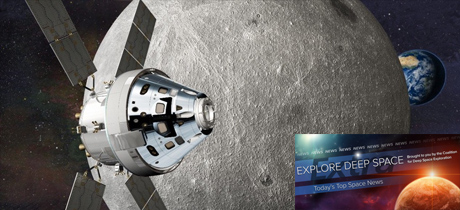In Today’s Deep Space Extra… NASA and Lockheed Martin reach agreement for the long term production of the Orion capsules that are to lead to a sustainable human presence at the Moon to prepare for future expeditions to Mars. NASA and the Japanese space agency JAXA issue statement of joint commitment to their ongoing collaboration. NASA embraces a mid-2020s mission to launch a space telescope for the detection of asteroid impact threats to the Earth.
Human Space Exploration
NASA awards long-term Orion production contract to Lockheed Martin
Coalition Member in the News – Lockheed Martin
SpaceNews.com (9/23): NASA announced the award of a $4.6 billion agreement to Lockheed Martin on Monday to begin the production of six Orion crew capsules for Artemis Moon missions with astronauts on board. The first build is for Artemis 3, the first mission to return to the lunar surface with astronauts and planned for 2024. NASA and Lockheed intend to demonstrate that some Artemis hardware can be reflown to help manage costs.
NASA and JAXA issues joint statement on cooperation in lunar exploration
Global JAXA (9/23): Japanese Aerospace Exploration Agency (JAXA) President Dr. Hiroshi Yamakawa and NASA Administrator Jim Bridenstine met today to discuss ongoing cooperation in space, to include the lunar vicinity and the eventual exploration of Mars, issuing a joint statement of commitment for continuing collaboration.
NASA to air rescheduled launch capture of cargo ship to Space Station
NASA.gov (9/23): A Japanese cargo spacecraft launch delayed by a fire at the mobile launch pad in Japan, is on track for launch to the International Space Station (ISS) today at 12:05 pm EDT. NASA will provide live coverage on NASA TV.
NASA to tear down building where Neil Armstrong, colleagues were quarantined after Moon mission
Houston Chronicle (9/23): NASA’s Lunar Receiving Lab, the enclosure at the Johnson Space Center (JSC) that housed the Apollo astronauts and their Moon rocks in quarantine upon their return from the Moon, is now in disrepair and soon to be torn down. Some equipment will be preserved for display. The three week quarantine period was to ensure the astronauts and materials did not pose a disease threat.
Space Science
NASA announces new mission to search for asteroids
Spacepolicyonline.com (9/23): NASA will develop an infrared space telescope for launch in the mid-2020’s to aid in the identification of near Earth orbits that could pose an impact threat, Thomas Zurbuchen, NASA’s associate administrator for science, told an agency advisory panel in Washington on Monday. The project is based on the Near Earth Object camera, or NEOcam, that has been in development for 15 years. Congress has assigned NASA the task of identifying 90 percent of all NEO threats larger than 140 meters. The cost of the space telescope missions is estimated at $500 million to $600 million.
CME impact could spark auroras this week
Spaceweather.com (9/23): Bright arctic auroras are possible this week thanks to the sun’s release of a powerful coronal mass ejection on September 20. The ejection sent a salvo of powerful solar energy towards the Earth’s magnetic field. The CME could reach Earth on Wednesday to trigger the arctic display.
Venus may have supported life billions of years ago
Space.com (9/23): Studies by NASA’s Goddard Institute for Space Studies suggest that Venus may have had a habitable environment for 2 to 3 billion years after the solar system formed. NASA’s Pioneer Venus mission even found evidence for past shallow oceans on the surface. The Goddard simulations suggest that something happened on the order of 700 million years ago that triggered a runaway greenhouse effect.
Other News
Clusters, not constellations, pose biggest orbital debris risk
SpaceNews.com (9/23): Clusters of rocket bodies in low Earth orbit and launched by Russia between 1980 and 2000 pose a greater risk to functioning satellites that growing constellations of small satellites, according to Darren McKnight, of Centauri. He was among experts participating in the recent Advanced Maui Optical and Space Surveillance Technologies, or AMOS, conference in Wailea, Hawaii. Weighing a ton or more, these objects cannot be maneuvered.
Brad Pitt’s ‘Ad Astra’ is one big, shiny ad for Lockheed Martin
Coalition Member in the News – Lockheed Martin
Daily Beast (9/20): Maryland based Lockheed Martin made significant contributions to the production of Ad Astra, the space exploration film epic starring Brad Pitt that opened in theaters last Friday. Lockheed consulted on the design of the film’s spacecraft, space stations, Moon landers and other technologies and also paid Disney, the production studio, to place the company logo on film costumes and props.
Homeowners reject SpaceX buyout offer
Valley Morning Star (9/22): Efforts by SpaceX to acquire residential property in Boca Chica, Texas, adjacent to SpaceX facilities where the development of the Starship and Super Heavy are underway, has met with some resistance from home owners not eager to sell.

